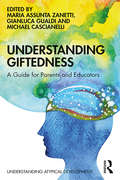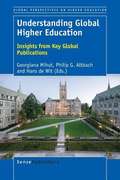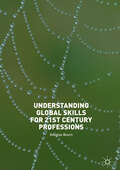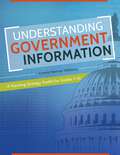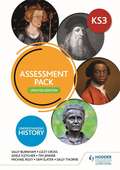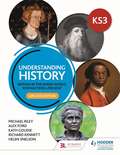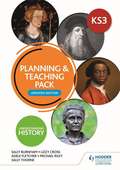- Table View
- List View
Understanding Family Diversity and Home - School Relations: A guide for students and practitioners in early years and primary settings
by Gianna Knowles Radhika HolmstromHow can adults in Early Years settings and primary schools fully embrace the diverse nature of family life of the children they are working with? This essential text will help students and those already working with children to understand both theoretically and practically, what may constitute a ‘family’. It explores how to build relationships with a child’s family to ensure early years settings and schools are working in partnership with children’s home environments, thereby supporting the best possible learning outcomes for children. It will help the reader to develop their skills, knowledge and understanding of their professional practice in education, and chapter by chapter explores the challenges that may be experienced in working with the diverse nature of family life in the UK, including: mixed race families immigrant, refugee and asylum seeker families step-families and step-parenting gay and lesbian families families and adoption fostering and children in care families living in poverty families and bereavement families and disability (including mental health). Understanding Family Diversity and Home-School Relations is engagingly practical, using case study examples throughout, and providing reflective activities to help the reader consider how to develop their practice in relation to the insights this book provides. It is a unique road-map to understanding pupils’ backgrounds, attitudes and culture and will be essential reading for any student undertaking relevant Foundation and BA Degrees, including those in initial teacher training, taking post-graduate qualifications or as part of a practitioner’s professional development.
Understanding Forensic Digital Imaging
by Herbert L. Blitzer Karen Stein-Ferguson Jeffrey HuangUnderstanding Forensic Digital Imaging offers the principles of forensic digital imaging and photography in a manner that is straightforward and easy to digest for the professional and student. It provides information on how to photograph any setting that may have forensic value, details how to follow practices that are acceptable in court, and recommends what variety of hardware and software are most valuable to a practitioner. In addition to chapters on basic topics such as light and lenses, resolution, and file formats, the book contains forensic-science-specific information on SWGIT and the use of photography in investigations and in court. Of particular note is Chapter 17, Establishing Quality Requirements, which offers information on how to create a good digital image, and is more comprehensive than any other source currently available.Covers topics that are of vital importance to the practicing professionalServes as an up-to-date reference in the rapidly evolving world of digital imagingUses clear and concise language so that any reader can understand the technology and science behind digital imaging
Understanding French Verse: A Guide for Singers
by David HunterUnderstanding French Verse: A Guide for Singers explains the formal structure of the French language and sets out the basics of French versification, using examples drawn from a wide range of well-known song settings. In clear and concise style, it explains the Alexandrine meter typically used in French-language poetry, how to distinguish different meters by counting syllables, how to identify stresses and rhyme in French verse, and ultimately, how to enhance the interpretation and enjoyment of the melodie . The book also offers valuable resources, including a brief history of French versification, detailed analysis of several poems, a glossary of technical terms, and suggestions for further reading. While other books help singers with French diction, or offer translations of French texts, no other book helps a singer understand the meaning behind what they are singing. Understanding French Verse is an essential tool for singers, accompanists, and other musicians who want to understand more about the French texts with which they are working.
Understanding Gender and Early Childhood: An Introduction to the Key Debates
by Jo Josephidou Polly BolshawUnderstanding Gender and Early Childhood is a comprehensive and accessible introduction into the main issues around gender and what these mean for our youngest children. Drawing on key theories and research, and illustrating each topic with case studies, reflective questions and a summary of key points, students are encouraged to question why it is more relevant than ever to consider gender issues and to reflect critically on their own practice and on the practice of others. The three parts examine gender in relation to the children, the workforce and wider society, concluding with inclusive suggestions for the future of the early years classroom. Topics covered include: how gender impacts on children’s play, learning and achievement, the gender imbalance in the early years workforce and the impact of this on children, the gendered ways in which people engage with children, gender issues in children’s health. This book is an essential read for those studying on Early Years and Early Childhood courses, along with practitioners and anyone else who wants to develop their understanding of the most pressing issues relating to gender and early childhood practice.
Understanding Gender and Early Childhood: An Introduction to the Key Debates
by Jo Josephidou Polly BolshawUnderstanding Gender and Early Childhood is a comprehensive and accessible introduction into the main issues around gender and what these mean for our youngest children. Drawing on key theories and research, and illustrating each topic with case studies, reflective questions and a summary of key points, students are encouraged to question why it is more relevant than ever to consider gender issues and to reflect critically on their own practice and on the practice of others. The three parts examine gender in relation to the children, the workforce and wider society, concluding with inclusive suggestions for the future of the early years classroom. Topics covered include: how gender impacts on children’s play, learning and achievement, the gender imbalance in the early years workforce and the impact of this on children, the gendered ways in which people engage with children, gender issues in children’s health. This book is an essential read for those studying on Early Years and Early Childhood courses, along with practitioners and anyone else who wants to develop their understanding of the most pressing issues relating to gender and early childhood practice.
Understanding Geographical and Environmental Education: The Role Of Research
by Michael C. WilliamsThese papers aim to provide a substantial review of the literature pertaining to a comprehensive range of traditional and contemporary research paradigms and research methods. The book is designed as a reference work for novice researchers in the fields of geographical and environmental education.
Understanding Giftedness: A guide for parents and educators (Understanding Atypical Development)
by Gianluca Gualdi Maria Assunta Zanetti Michael CascianelliThis concise, accessible guide explores the different models behind the concept of giftedness, examining the criteria for evaluating and identifying gifted children, in order to provide a deeper understanding of the lives of children and young people with high cognitive potential. It offers practical advice to parents and teachers, highlighting common queries and misconceptions and presenting evidence-based suggestions for management methods. Key topics covered include the difference between being gifted and talented, how to identify a gifted child, neurological differences between gifted children and their peers, dealing with perfectionism, and the best ways to parent and teach a gifted child. Avoiding prescriptive rules, the authors emphasise the importance of knowing and understanding the individual child whilst utilising research around giftedness to promote the best possible outcomes. Illustrated with case studies of student and teacher perspectives, the book offers an inclusive perspective and practical strategies, whereby the development of individual potential is viewed not only as a way to promote the psychological well-being of the individual but also as an opportunity and benefit for society. Understanding Giftedness is essential reading for parents and caregivers, as well as practitioners in clinical and educational psychology, counselling, mental health, nursing, child welfare, public healthcare and those in education who want to help young people develop their talents and achieve their full potential.
Understanding Giftedness: A guide for parents and educators (Understanding Atypical Development)
by Gianluca Gualdi Maria Assunta Zanetti Michael CascianelliThis concise, accessible guide explores the different models behind the concept of giftedness, examining the criteria for evaluating and identifying gifted children, in order to provide a deeper understanding of the lives of children and young people with high cognitive potential. It offers practical advice to parents and teachers, highlighting common queries and misconceptions and presenting evidence-based suggestions for management methods. Key topics covered include the difference between being gifted and talented, how to identify a gifted child, neurological differences between gifted children and their peers, dealing with perfectionism, and the best ways to parent and teach a gifted child. Avoiding prescriptive rules, the authors emphasise the importance of knowing and understanding the individual child whilst utilising research around giftedness to promote the best possible outcomes. Illustrated with case studies of student and teacher perspectives, the book offers an inclusive perspective and practical strategies, whereby the development of individual potential is viewed not only as a way to promote the psychological well-being of the individual but also as an opportunity and benefit for society. Understanding Giftedness is essential reading for parents and caregivers, as well as practitioners in clinical and educational psychology, counselling, mental health, nursing, child welfare, public healthcare and those in education who want to help young people develop their talents and achieve their full potential.
Understanding Girls: Quantitative and Qualitative Research (Cultural Perspectives in Science Education)
by Dale Rose BakerUnderstanding Girls: Quantitative and Qualitative Research is a retrospective of the author’s research that led to receiving the 2013 Distinguished Contributions Award to Science Education through Research. This book includes selected articles that document changes in her research approaches and theoretical frameworks. The articles represent the evolution of her thinking about the issue of girls in science as well as her impact on science education. The author’s work is placed in the context of science education research at the time of publication, research in education and psychology, and the culture of the times. She pulls back the curtain that often makes the messy work of research seem straightforward and linear to reveal why she did the research and the methodological decisions she faced. She describes the serendipitous nature of some of the work as well as her frustrations in trying to understand data, and struggles to insure that she accurately and respectfully presented the voices of girls and their teachers. The book also includes some of the earliest research in engineering education preceding the focus on engineering practices found in the Next Generation Science and Engineering Standards. Understanding Girls provides insights into why girls may or may not decide to participate in science and engineering and what can be done to increase their participation. It provides evidence that we have increased girls’ participation and the challenges that remain to insure that every girl who wants to become a scientist or engineer has the opportunity to do so.
Understanding Girls' Friendships, Fights and Feuds: A Practical Approach To Girls' Bullying (UK Higher Education OUP Humanities & Social Sciences Education OUP)
by Valerie BesagGirls’ bullying is more subtle and less physical than that perpetrated by boys; however, it can be just as powerful, and the emotional repercussions of bullying among girls can be more destructive and longer lasting than the effects of more obvious forms of bullying. Teachers report that quarrels between girls are far more time-consuming and difficult to resolve than the disputes of boys, yet not enough information is available to guide them on dealing with girls’ fighting and unhappiness caused by their relationships with other girls, many of whom may have been their closest friends.Understanding Girls’ Friendships, Fights and Feuds illuminates the issue of girls’ bullying – an issue that can cause a great deal of distress but which is sometimes ignored or dismissed by adults. Drawing on close observations of girls’ behaviour, Val Besag provides an in-depth understanding of girls’ bullying, exploring the mechanisms and language that girls use to entice some into their groups and exclude others. The book offers detailed practical advice for dealing with girls’ bullying, which will help both students and teachers to understand and combat different kinds of bullying, as well as comprehensive guidance for preventing or reducing bullying activities among girls, including: Whole school approaches Programmes for developing emotional literacy and resilienceApproaches for dealing with gangsUsing methods such as art and drama Developing conflict resolution skills Student – parent programmesPeer support programmesThis is key reading for teachers, trainee teachers, educational psychologists and social workers, academics and researchers in the field, and others who have an interest in creating bully-free schools and societies.
Understanding Global Higher Education: Insights from Key Global Publications
by Georgiana Mihut Philip G. Altbach Hans De WitThis volume brings together selected articles published in University World News (UWN) and International Higher Education (IHE) between 2011 and 2016. Researchers, policy makers, and practitioners alike further the development of higher education as a field of study through public and ongoing conversations. It is news, analysis, and commentary publications like UWN and IHE that facilitate this dialogue and keep pace with the most up-to-date developments in the field. Together, the articles included in this volume—alongside the section introductions—offer a rich and relevant picture of the dynamic state of higher education globally. While both publications are freely available online, this book provides a thematically coherent selection of articles, offering an accessible and analytic perspective on the pressing concerns of contemporary higher education.
Understanding Global Higher Education: Insights from Key Global Publications (Global Perspectives on Higher Education)
by Georgiana Mihut Philip G. Altbach Hans De WitThis volume brings together selected articles published in University World News (UWN) and International Higher Education (IHE) between 2011 and 2016. Researchers, policy makers, and practitioners alike further the development of higher education as a field of study through public and ongoing conversations. It is news, analysis, and commentary publications like UWN and IHE that facilitate this dialogue and keep pace with the most up-to-date developments in the field. Together, the articles included in this volume—alongside the section introductions—offer a rich and relevant picture of the dynamic state of higher education globally. While both publications are freely available online, this book provides a thematically coherent selection of articles, offering an accessible and analytic perspective on the pressing concerns of contemporary higher education.
Understanding Global Skills for 21st Century Professions
by Douglas BournThis book highlights the increasing need for people who will be working in professions such as teaching, health, engineering and business management to have the skills for living and working in a global society. Globalisation and the challenges resulting from recent political events in Europe and North America have given rise to a need for training and further and higher education programmes to address the skills young people all need to effectively engage in the current global society. Reviewing the range of theories and debates surrounding skills for the twenty-first century, the author suggests there is a need to directly address the real-world issues of today and move beyond abstract concepts such as team work, critical thinking and problem solving, as important as these concepts are. The author proposes a new framework for global skills using examples from international and national policy-makers and evidence from further and higher educational programmes and training courses. This pioneering yet practical book will be of value to students and scholars of global education as well as practitioners and policy makers.
Understanding Government Information: A Teaching Strategy Toolkit for Grades 7–12
by Connie Hamner WilliamsThis book demonstrates how government information can be used to engage students through inquiry and project-based activities, thereby providing opportunities for creative investigation and discovery.Many government agencies and institutions provide educators with curricula, lesson plans, data, and direction—all of it free. But to access this largely hidden world of government information, one needs an understanding of how this government information is organized and knowledge about how to best utilize the finding aids, databases, and other search mechanisms to help guide effective research. This guidebook shows you how to locate high-quality, effective lesson plans developed by the nation's best educators, access reliable government data, and find curated lists of free government sources that are theme-based and reference national standards in social studies and health.Understanding Government Information: A Teaching Strategy Toolkit for Grades 7–12 is ideal for middle school and high school librarians and teachers in all subject areas, public youth services librarians, as well as parents teaching their students in home school based programs. You'll learn how to access expert-developed lesson plans, documents, images, and other primary sources along with suggested activities. The book also includes a teacher toolkit that details strategies for lessons and student activities that can be used across the curriculum.
Understanding Government Information: A Teaching Strategy Toolkit for Grades 7–12
by Connie Hamner WilliamsThis book demonstrates how government information can be used to engage students through inquiry and project-based activities, thereby providing opportunities for creative investigation and discovery.Many government agencies and institutions provide educators with curricula, lesson plans, data, and direction—all of it free. But to access this largely hidden world of government information, one needs an understanding of how this government information is organized and knowledge about how to best utilize the finding aids, databases, and other search mechanisms to help guide effective research. This guidebook shows you how to locate high-quality, effective lesson plans developed by the nation's best educators, access reliable government data, and find curated lists of free government sources that are theme-based and reference national standards in social studies and health.Understanding Government Information: A Teaching Strategy Toolkit for Grades 7–12 is ideal for middle school and high school librarians and teachers in all subject areas, public youth services librarians, as well as parents teaching their students in home school based programs. You'll learn how to access expert-developed lesson plans, documents, images, and other primary sources along with suggested activities. The book also includes a teacher toolkit that details strategies for lessons and student activities that can be used across the curriculum.
Understanding Higher Education Internationalization: Insights from Key Global Publications (Global Perspectives on Higher Education)
by Georgiana Mihut Philip G. Altbach Hans De WitThis volume brings together selected articles focused on higher education internationalization published in University World News (UWN) and International Higher Education (IHE) between 2011 and 2016. Researchers, policy makers, and practitioners alike further the development of higher education internationalization as a field of study through public and ongoing conversations. It is news, analysis, and commentary publications like UWN and IHE that facilitate this dialogue and keep pace with the most up-to-date developments in the field. Together, the articles included in this volume—alongside the section introductions—offer a rich and relevant picture of the dynamic state of higher education internationalization globally. While both publications are freely available online, this book provides a thematically coherent selection of articles, offering an accessible and analytic perspective on the pressing concerns of contemporary higher education internationalization.
Understanding Hinduism: A Guide for Teachers (Teaching Religions and Worldviews)
by James D. HoltThis book explores the beliefs and practices of Hinduism as a lived religion and engages with Hindu beliefs and practices, including the concepts that form the central beliefs of Hinduism, and the expression of these beliefs in worship and daily life. The book uses the authentic voices of practicing Hindus to highlight differences in the ways Hinduism is understood and lived in different circumstances. The diversity of Hindu expression is one of the complex elements of Hinduism, and it is also one of its strengths. This book makes this diversity the centre of its exploration. Each chapter enables the reader to consider the concepts and how they can be taught in the classroom. The author also provides suggestions for activities that could be utilised within the classroom to help others to understand the richness and vibrancy of Hinduism.
Understanding Hinduism: A Guide for Teachers (Teaching Religions and Worldviews)
by James D. HoltThis book explores the beliefs and practices of Hinduism as a lived religion and engages with Hindu beliefs and practices, including the concepts that form the central beliefs of Hinduism, and the expression of these beliefs in worship and daily life. The book uses the authentic voices of practicing Hindus to highlight differences in the ways Hinduism is understood and lived in different circumstances. The diversity of Hindu expression is one of the complex elements of Hinduism, and it is also one of its strengths. This book makes this diversity the centre of its exploration. Each chapter enables the reader to consider the concepts and how they can be taught in the classroom. The author also provides suggestions for activities that could be utilised within the classroom to help others to understand the richness and vibrancy of Hinduism.
Understanding History: Key Stage 3: Assessment Pack: Updated Edition
by Sally Thorne Lizzy Cross Sally Burnham Adele Fletcher Sam Slater Tim JennerSkilfully assess pupils' knowledge and skills, providing evidence of their achievement as they progress through the Understanding History course and build towards GCSE.> Monitor pupils' progress in their written work: indicative answers for the end-of-enquiry assessment tasks in the Student Book are annotated to show the features of a strong response and can be shared with pupils for peer/self-assessment> Check pupils' understanding regularly and flexibly: a baseline assessment, half-termly written tests and a bank of 600 knowledge check questions provide formative and summative assessment opportunities> Prepare students for the requirements of your GCSE specification: GCSE skills sheets based on the Student Book target specific skills that are assessed under the Pearson Edexcel, AQA and OCR B specifications
Understanding History: Key Stage 3: Britain in the wider world, Roman times–present: Updated Edition
by Michael Riley Alex Ford Kath Goudie Richard Kennett Helen SnelsonHelp every pupil to know more, look closer, think deeper and write better as they develop their historical knowledge and skills throughout Key Stage 3 and get 'GCSE-ready'.Exploring the stories of fascinating people, places and events through an enquiry approach, this Student Book familiarises KS3 pupils with the different ways of thinking required for thematic, period, depth and site studies at GCSE.> Easily and cost-effectively implement a new KS3 curriculum: this coherent single-book course contains 120 lessons that experienced and non-specialist teachers can deliver with confidence, across a two or three-year KS3> Establish strong foundational knowledge of British History: the content has been meticulously selected to provide a chronological spine that contextualises GCSE content, saving you valuable time when teaching GCSE> Focus on building writing skills: GCSE-style command words and question types are introduced gradually, developing the extended writing skills that pupils need to reach the highest marks, whichever GCSE specification you follow> Effectively assess and demonstrate progress: regular activities throughout the Student Book lead to end-of-enquiry tasks, supporting both formative and summative assessment of pupils' conceptual understanding and writing skills> Generate enthusiasm and respect for historical evidence: pupils are encouraged to use sources and interpretations as part of their historical investigations, leading to a natural improvement in their analytical and evaluative skills
Understanding History: Key Stage 3: Planning & Teaching Pack: Updated Edition
by Sally Thorne Lizzy Cross Sally Burnham Adele FletcherDeliver an outstanding KS3 curriculum using this photocopiable pack of carefully sequenced lesson plans and activity worksheets for the Understanding History course.> Pick up and teach the course with ease: every lesson in the Student Book has a detailed lesson plan with learning outcomes, suggestions for stretch and challenge, a lesson starter, activities and a review/plenary that includes a low-stakes knowledge check and a deeper learning check> Support, build upon and go beyond the activities in the Student Book: 177 ready-made worksheets (at least one per lesson) help to develop pupils' knowledge, understanding, vocabulary and writing skills as they progress through the course> Use the Student Book flexibly for any length of KS3: the course planners provide an overview of how to teach the course in 6 or 9 terms, so those following a 3-year curriculum can incorporate their existing favourite lessons
Understanding HIV and STI Prevention for College Students (Routledge Research in Higher Education)
by Leo Wilton Robert T. Palmer Dina C. MarambaAccording to the Centers for Disease Control and Prevention, young people aged 18 to 25 are at a significant risk for acquiring and transmitting HIV (Human Immunodeficiency Virus) and other STIs (sexually transmitted infections). Primary developmental processes that place college students particularly at risk include the experience of intimacy, sexual desires and the centrality of the peer group. During these routine developmental processes, college students experiment with unprotected sex, multiple sex partners and alcohol and illicit drugs, all of which are contributing risk factors for HIV/STI infections. Early diagnosis, treatment and prevention of HIV and other STIs is germane to promoting the sexual health of college students and reducing high HIV/STI infection rates among young people. This edited volume will provide innovative and cutting-edge approaches to prevention for college students and will have a major impact on advancing the interdisciplinary fields of higher education and public health. It will explore core ideas such as hooking up culture, sexual violence, LGBT and students of color, as well as HIV and STI prevention in community colleges, rural colleges and minority serving institutions.
Understanding HIV and STI Prevention for College Students (Routledge Research in Higher Education)
by Leo Wilton Robert T. Palmer Dina C. MarambaAccording to the Centers for Disease Control and Prevention, young people aged 18 to 25 are at a significant risk for acquiring and transmitting HIV (Human Immunodeficiency Virus) and other STIs (sexually transmitted infections). Primary developmental processes that place college students particularly at risk include the experience of intimacy, sexual desires and the centrality of the peer group. During these routine developmental processes, college students experiment with unprotected sex, multiple sex partners and alcohol and illicit drugs, all of which are contributing risk factors for HIV/STI infections. Early diagnosis, treatment and prevention of HIV and other STIs is germane to promoting the sexual health of college students and reducing high HIV/STI infection rates among young people. This edited volume will provide innovative and cutting-edge approaches to prevention for college students and will have a major impact on advancing the interdisciplinary fields of higher education and public health. It will explore core ideas such as hooking up culture, sexual violence, LGBT and students of color, as well as HIV and STI prevention in community colleges, rural colleges and minority serving institutions.
Understanding How Asperger Children and Adolescents Think and Learn: Creating Manageable Environments for AS Students
by Paula JacobsenJacobsen provides an inside view of how AS pupils perceive and understand what goes on in the classroom, and how they are perceived by fellow pupils and teachers. She adopts a pragmatic approach to improving communication in the classroom and offers practical strategies to increase mutual understanding and create a supportive learning environment.
Understanding How We Learn
by Yana Weinstein Megan Smith Oliver Caviglioli Megan SumerackiEducational practice does not, for the most part, rely on research findings. Instead, there's a preference for relying on our intuitions about what's best for learning. But relying on intuition may be a bad idea for teachers and learners alike. This accessible guide helps teachers to integrate effective, research-backed strategies for learning into their classroom practice. The book explores exactly what constitutes good evidence for effective learning and teaching strategies, how to make evidence-based judgments instead of relying on intuition, and how to apply findings from cognitive psychology directly to the classroom. Including real-life examples and case studies, FAQs, and a wealth of engaging illustrations to explain complex concepts and emphasize key points, the book is divided into four parts: Evidence-based education and the science of learning Basics of human cognitive processes Strategies for effective learning Tips for students, teachers, and parents. Written by "The Learning Scientists" and fully illustrated by Oliver Caviglioli, Understanding How We Learn is a rejuvenating and fresh examination of cognitive psychology's application to education. This is an essential read for all teachers and educational practitioners, designed to convey the concepts of research to the reality of a teacher's classroom.





